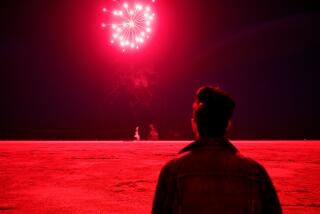Fireworks Are Burned Into Cultural Psyche
- Share via
As that first burst of burning magnesium tears across the sky Friday and the initial shock wave rattles through your chest, announcing the arrival of the yearly Independence Day fireworks show, it may be worth taking a moment to consider the concept of sublimity in early modern Europe.
Or incendiary sexual metaphors in literature.
Or San Juan de Dios--said to be the patron saint of carbon in one Mexican village, keeping watch over the local pyrotechnicians.
Fireworks, says Kevin Salatino of the Getty Research Institute for the History of Art and the Humanities, are “about politics, they’re about propaganda, sex, sublimity, about order over chaos. They are about intellectual illumination. They are a memento mori--a reminder of death.”
And you thought it was about bright lights and big bangs.
The cultural history of the beautiful bombs is a wild one that began in China 800 years ago, exploded with pomposity over Louis XIV’s grand festivals at Versailles, became a none-too-subtle metaphor for sex in the writings of James Joyce and others, and marches every summer night across the sky over Disneyland.
Of course, “You don’t have to know much about fireworks to know what a good show is,” said Bill Elias, a chemist at Hughes Aircraft in El Segundo and a lifelong fireworks aficionado.
“At a good fireworks show, when you walk away from it, you feel something,” said the 36-year-old, who spends his off hours studying the history of pyrotechnics, designing elaborate displays, including the annual July 4 one sponsored by the city of El Segundo, and firing off rockets like he did as a kid. “You feel something personal.”
The presentation of fireworks has evolved considerably since the time when Chinese peasants shooed away evil spirits with bamboo spears jammed with saltpeter, sulfur and charcoal. Many large displays are now digitally ignited and synchronized to the music of giant orchestras.
But the shells themselves are much like those of centuries past, experts say, most constructed of relatively simple chemical compounds and still delicately molded by hand--lest malfunctioning machinery set off a spark.
Fireworks first arrived in the West from the Far East during the 14th century. And the amazing toys soon spread throughout Europe.
The first recorded display in Great Britain came in 1486, at the wedding of Henry VII. But England’s ambivalent relationship with pyrotechnics was born on Nov. 5, 1605, when a Catholic mercenary named Guy Fawkes and 12 co-conspirators tried to blow up King James I and his Parliament with 20 barrels of gunpowder. The plot was foiled, the conspirators all killed, and anti-Catholic sentiment heightened.
Brits commemorate the Gunpowder Plot each fall by lighting up some fireworks of their own and burning Fawkes in effigy.
By the mid-18th century, elaborate displays with aerial explosions as well as set pieces--from rocket-powered pinwheels to a faux Vesuvius--were held throughout Europe, both as public events for those who could afford to attend them and displays reserved for the aristocracy. But they had become much more than mere fun, according to Salatino, curator of one of the Getty’s inaugural exhibits planned for December, “Incendiary Art: The Representation of Fireworks in Early Modern Europe.”
Louis XIV’s grandiose displays involved “complex allegorical themes that told a narrative,” says Salatino, the institute’s curator of graphic arts, special collections.
“Mostly what that story said is, ‘The king is powerful and all of Europe should recognize that.’ ”
Fireworks displays also enabled royal sponsors and their 18th century audiences to participate in a double-edged fantasy: The king wanted to show he was powerful enough to control nature, and his subjects, in that era’s notion of sublimity, could experience terror from a safe distance. “The best example of the sublime in the second half of the 20th century is special effects in movies,” Salatino says.
In the early 19th century, fireworks became far more brilliantly colored when European scientists added chlorates and other newfound compounds.
By the early 20th century, Joyce was using Roman candles as a metaphor for orgasm in his censored “Ulysses.”
As the 20th century winds down, fireworks displays are often commercial ventures synonymous with corporate names like Disney, which in a gesture of goodwill toward neighbors now uses smaller, quieter shells. Cigarette manufacturer Benson and Hedges sponsors pyrotechnic competitions.
Pyrotechnicians swap explosive recipes over the Internet and debate the relative qualities of the cylindrical Italian-style shells vs. the round Asian-style mortars.
Computer-driven “pyro-musicals,” as Elias called them, are increasingly popular.
It will be a computer giving the electronic signal at Disneyland--and a host of other Los Angeles-area shows--sending 500 hand-crafted “comets,” “mines” and fountain-like “gerbs” up into the night as “The Star-Spangled Banner” and Disney movie theme songs blare from a digital sound system. The concussive “thumps” will be less likely to interrupt the rhythm of your heartbeat than a decade ago. And no, the corporate folks don’t care to reveal just how much they’re spending on the show.
But in the end, “We blow a whole bunch of stuff up,” said Tim Runco, Disneyland’s general manager and director of entertainment. “Some people like the music . . . the emotional impact. I just like to get knocked over by them all.”
What could be more American?
More to Read
The biggest entertainment stories
Get our big stories about Hollywood, film, television, music, arts, culture and more right in your inbox as soon as they publish.
You may occasionally receive promotional content from the Los Angeles Times.










